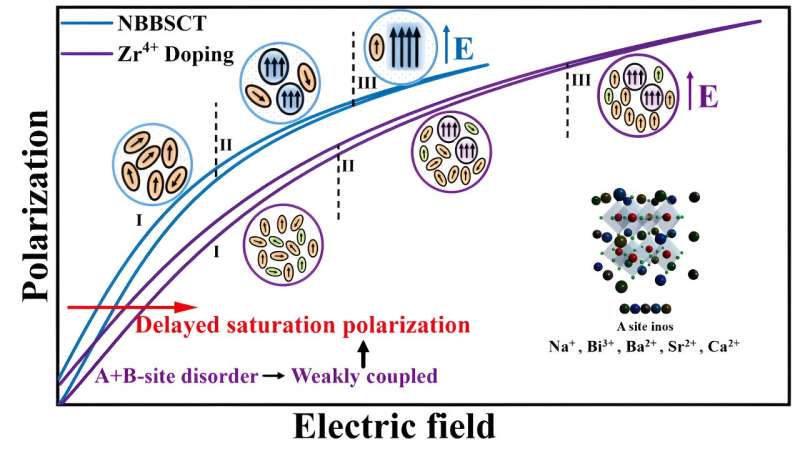This article has been reviewed according to Science X's editorial process and policies. Editors have highlighted the following attributes while ensuring the content's credibility:
fact-checked
proofread
An effective method for improving energy storage performance in lead-free relaxor ferroelectrics

Next-generation advanced high/pulsed power capacitors urgently require dielectric materials with outstanding energy storage performance. (Bi0.5Na0.5)TiO3-based material, a typical lead-free ferroelectrics, has the characteristics of high polarization strength and excellent component compatibility, making it emerge as a potential candidate for energy storage applications.
Researchers have made an interesting breakthrough in the modification of the BNT-based ferroelectrics, an effective method for various properties such as relaxor features and energy storage performance. The new method utilizes a high-entropy concept to create A-site BNT-based high-entropy relaxor ferroelectrics and add B-site disorder on this basis, which can further improve the ion disorder to reduce short-range order.
Thus, it is easier to form isolated and weak coupled polar nanoclusters in the dielectric matrix. This characteristic makes it obtain a high relaxor feature and delayed saturation polarization under an electric field, which is beneficial for good energy storage performance. This represents an important advancement over existing methods.
The traditional approach to creating relaxor ferroelectrics (RFEs) normally relies on doping heterogeneous ions to cause local compositional inhomogeneity and ion disorder to obtain polar nanoregions (PNRs). "But the solid solubility is limited, even though BNT has good component compatibility," Neng-Neng Luo, the leader of the research team, said, "the Gibbs phase rule tells us it is hard to further improve the ion disorder and relaxor feature by chemical doping."
This method overcomes this limitation by constructing a high entropy single-phase solid solution. Meanwhile, on the basis of the A-site disorder, an additional B-site disorder further breaks the size of PNRs and weakens the coupling between PNRs. The highly broken and weak coupled PNRs may restrict their growth into micro-domains under high electric fields, thereby leading to slimmer P–E loops and further prolonged polarization saturation.
This innovation not only provides new ideas for the design of ferroelectric materials but proves that a B-site modification strategy based on the A-site high-entropy disorder is also an effective way of improving energy storage density. Additionally, it could explain the domain change process of ferroelectric energy storage ceramics under an electric field.
Meanwhile, the research team is optimistic about the application of their work. They believe that the method, requiring no complex fabrication processes, could readily be achieved in high energy storage density with ultra-high efficiency.
The team published their work in the Journal of Advanced Ceramics.
This is an important development in the field of dielectric energy storage materials, and its potential applications are vast. The researchers' work highlights the power of combining advanced materials with innovative design concepts to achieve breakthroughs with far-reaching consequences.
More information: Kaihua Yang et al, Excellent energy storage performance in Bi0.5Na0.5TiO3-based lead-free high-entropy relaxor ferroelectrics via B-site modification, Journal of Advanced Ceramics (2024). DOI: 10.26599/JAC.2024.9220859

















